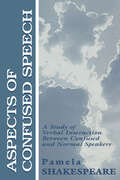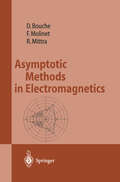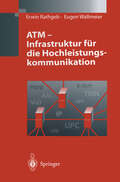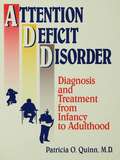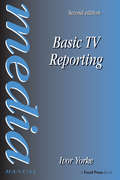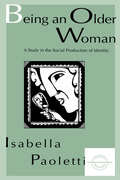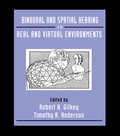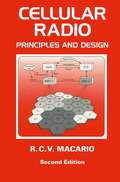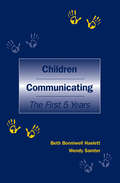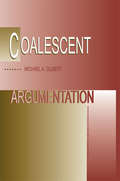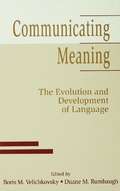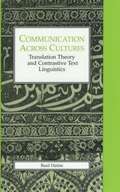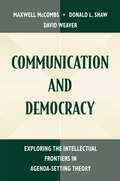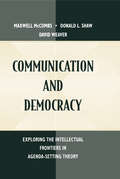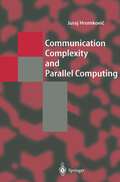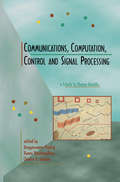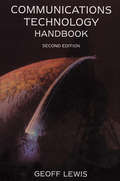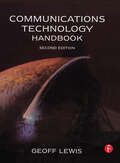- Table View
- List View
Aspects of Confused Speech: A Study of Verbal Interaction Between Confused and Normal Speakers
by Pamela ShakespeareBased on research focusing on the experience of having confused speech and being with confused speakers, this book begins with everyday, commonly understood ideas such as "talking too much" and examines how confused speech is "brought off" as a collaborative activity by the people involved. The author became involved in this project because she was interested in how "confusion" seemed to be something that everyone is not only involved in but also recognizes as part of ordinary life. At the same time, "confusion" is a word that is used somewhat as a blanket category for some people considered permanently incompetent and "set apart" from ordinary members of society. Her study analyzes how talk between confused and normal speakers throws light on this tension.
Asymptotic Methods in Electromagnetics
by Daniel Bouche Frederic Molinet Raj MittraNumerically rigorous techniques for the computation of electromagnetic fields diffracted by an object become computationally intensive, if not impractical to handle, at high frequencies and one must resort to asymptotic methods to solve the scattering problem at short wavelengths. The asymptotic methods provide closed form expansions for the diffracted fields and are also useful for eliciting physical interpretations of the various diffraction phenomena. One of the principal objectives of this book is to discuss the different asymptotic methods in a unified manner. Although the book contains explicit formulas for computing the field diffracted by conducting or dielectric-coated objects, it also provides the mathematical foundations of the different methods and explains how they are interrelated.
ATM - Infrastruktur für die Hochleistungskommunikation
by Erwin Rathgeb Eugen WallmeierDie Autoren stellen die technischen Aspekte vom ATM gemäß ihrer Relevanz für Entwickler und Entscheidungsträger dar. Das Auflisten von Standards wird auf das Nötigste eingeschränkt, das Hauptaugenmerk liegt auf grundsätzlichen, langfristig gültigen Aussagen zu Funktionen und Mechanismen.
Attention Deficit Disorder: Diagnosis And Treatment From Infancy To Adulthood (Basic Principles Into Practice Ser. #Vol. 13)
by Patricia O. QuinnPublished in 1996, Attention Deficit Disorder is a valuable contribution to the field of Psychiatry/Clinical Psychology.
Attention Deficit Disorder: Diagnosis And Treatment From Infancy To Adulthood
by Patricia O. QuinnPublished in 1996, Attention Deficit Disorder is a valuable contribution to the field of Psychiatry/Clinical Psychology.
Basic TV Reporting: Media Manuals (Media Manual Ser.)
by Ivor YorkeBasic TV Reporting is a practical, easy to read guide to the skills needed to become a successful television reporter - arguably the most demanding and glamorous job in journalism. The book describes the role in detail, how reporters fit into the editorial team and where their duties begin and end. Basic TV Reporting is a practical, easy to read guide to the skills needed to become a successful television reporter - arguably the most demanding and glamorous job in journalism. The book describes the role in detail, how reporters fit into the editorial team and where their duties begin and end.The late Ivor Yorke has enjoyed a wealth of experience to pass on to aspiring broadcast journalists, having spent more than 20 years as a writer, reporter, producer and editor, before becoming Head of Journalist Training, BBC News and Current Affairs. He was also a freelance training consultant. He is the author of Television News (now in its third edition) and co-author with the late Bernard Hesketh of An Introduction to ENG, also published by Focal Press.Reviews: `This is a short, well-constructed book which is of as much value to the interviewed as to the interviewer. It is practical and down-to-earth (`keep off the gin, and stick to the tonic') and delightfully easy to read.' British Journal of Educational Technology.' Easy to read guide to the skills needed to become a successful TV reporter.'Voice of the Listener
Basic TV Reporting
by Ivor YorkeBasic TV Reporting is a practical, easy to read guide to the skills needed to become a successful television reporter - arguably the most demanding and glamorous job in journalism. The book describes the role in detail, how reporters fit into the editorial team and where their duties begin and end. Basic TV Reporting is a practical, easy to read guide to the skills needed to become a successful television reporter - arguably the most demanding and glamorous job in journalism. The book describes the role in detail, how reporters fit into the editorial team and where their duties begin and end.The late Ivor Yorke has enjoyed a wealth of experience to pass on to aspiring broadcast journalists, having spent more than 20 years as a writer, reporter, producer and editor, before becoming Head of Journalist Training, BBC News and Current Affairs. He was also a freelance training consultant. He is the author of Television News (now in its third edition) and co-author with the late Bernard Hesketh of An Introduction to ENG, also published by Focal Press.Reviews: `This is a short, well-constructed book which is of as much value to the interviewed as to the interviewer. It is practical and down-to-earth (`keep off the gin, and stick to the tonic') and delightfully easy to read.' British Journal of Educational Technology.' Easy to read guide to the skills needed to become a successful TV reporter.'Voice of the Listener
Being An Older Woman: A Study in the Social Production of Identity (Everyday Communication Series)
by Isabella PaolettiThe study presented in this volume examines how older women's identities are socially constructed and, in particular, how they can be influenced by institutional intervention. The interest in identity production is not only theoretical, but also practical. Different perceptions of oneself as an older woman involve considerable differences in the definition of that person's possible sphere of action, and therefore, in her life perspectives. The data -- collected during a four-year project studying older women -- consist of video recordings of the committee meetings of the Older Women's Group of Perugia, Italy. Other video recordings of theater workshops and of the management committee meetings of the Senior Citizen Centers in Perugia are used as a source of comparison. Transcripts of the video material are analyzed through a detailed discourse analysis within an ethnomethodological framework. The data are used to explore how gender and age identities are interactionally constructed in specific institutional contexts. The first part of the book focuses on the interactional construction of aging. It shows how "being old" is constructed conversationally, in particular, through the use of membership categories. Distancing from the category "old" and denial of aging are frequently encountered conversational moves. However, the category is perceived as acceptable, even desired and invoked, when it becomes an institutionally relevant category, giving access to interesting activities or special benefits. The second part of the book explores gender identification. Conflict among different institutional subjects is shown to fade into gender conflict. The study analyzes how institutional interventions exert a powerful influence on older women's identities, giving them new opportunities for action. It also looks at how the conversational styles, attitudes, and activities of specific women influence the features of those very institutions. In short, this book describes the discourse and social practices that constitute older women's identities -- helping to identify and deconstruct stereotypes that tend to produce marginalization of older people. The book's existence is itself a contribution to the construction of older women as busy, lively, appealing human beings; it is the first research publication to emerge from The European Older Women's Project. Of interest to those in any discipline studying the topics of ethnomethodology, gender, aging, and identity.
Being An Older Woman: A Study in the Social Production of Identity (Everyday Communication Series)
by Isabella PaolettiThe study presented in this volume examines how older women's identities are socially constructed and, in particular, how they can be influenced by institutional intervention. The interest in identity production is not only theoretical, but also practical. Different perceptions of oneself as an older woman involve considerable differences in the definition of that person's possible sphere of action, and therefore, in her life perspectives. The data -- collected during a four-year project studying older women -- consist of video recordings of the committee meetings of the Older Women's Group of Perugia, Italy. Other video recordings of theater workshops and of the management committee meetings of the Senior Citizen Centers in Perugia are used as a source of comparison. Transcripts of the video material are analyzed through a detailed discourse analysis within an ethnomethodological framework. The data are used to explore how gender and age identities are interactionally constructed in specific institutional contexts. The first part of the book focuses on the interactional construction of aging. It shows how "being old" is constructed conversationally, in particular, through the use of membership categories. Distancing from the category "old" and denial of aging are frequently encountered conversational moves. However, the category is perceived as acceptable, even desired and invoked, when it becomes an institutionally relevant category, giving access to interesting activities or special benefits. The second part of the book explores gender identification. Conflict among different institutional subjects is shown to fade into gender conflict. The study analyzes how institutional interventions exert a powerful influence on older women's identities, giving them new opportunities for action. It also looks at how the conversational styles, attitudes, and activities of specific women influence the features of those very institutions. In short, this book describes the discourse and social practices that constitute older women's identities -- helping to identify and deconstruct stereotypes that tend to produce marginalization of older people. The book's existence is itself a contribution to the construction of older women as busy, lively, appealing human beings; it is the first research publication to emerge from The European Older Women's Project. Of interest to those in any discipline studying the topics of ethnomethodology, gender, aging, and identity.
Binaural and Spatial Hearing in Real and Virtual Environments
by Robert Gilkey Timothy R. AndersonThe current popular and scientific interest in virtual environments has provided a new impetus for investigating binaural and spatial hearing. However, the many intriguing phenomena of spatial hearing have long made it an exciting area of scientific inquiry. Psychophysical and physiological investigations of spatial hearing seem to be converging on common explanations of underlying mechanisms. These understandings have in turn been incorporated into sophisticated yet mathematically tractable models of binaural interaction. Thus, binaural and spatial hearing is one of the few areas in which professionals are soon likely to find adequate physiological explanations of complex psychological phenomena that can be reasonably and usefully approximated by mathematical and physical models. This volume grew out of the Conference on Binaural and Spatial Hearing, a four-day event held at Wright-Patterson Air Force Base in response to rapid developments in binaural and spatial hearing research and technology. Meant to be more than just a proceedings, it presents chapters that are longer than typical proceedings papers and contain considerably more review material, including extensive bibliographies in many cases. Arranged into topical sections, the chapters represent major thrusts in the recent literature. The authors of the first chapter in each section have been encouraged to take a broad perspective and review the current state of literature. Subsequent chapters in each section tend to be somewhat more narrowly focused, and often emphasize the authors' own work. Thus, each section provides overview, background, and current research on a particular topic. This book is significant in that it reviews the important work during the past 10 to 15 years, and provides greater breadth and depth than most of the previous works.
Binaural and Spatial Hearing in Real and Virtual Environments
by Robert H. Gilkey Timothy R. AndersonThe current popular and scientific interest in virtual environments has provided a new impetus for investigating binaural and spatial hearing. However, the many intriguing phenomena of spatial hearing have long made it an exciting area of scientific inquiry. Psychophysical and physiological investigations of spatial hearing seem to be converging on common explanations of underlying mechanisms. These understandings have in turn been incorporated into sophisticated yet mathematically tractable models of binaural interaction. Thus, binaural and spatial hearing is one of the few areas in which professionals are soon likely to find adequate physiological explanations of complex psychological phenomena that can be reasonably and usefully approximated by mathematical and physical models. This volume grew out of the Conference on Binaural and Spatial Hearing, a four-day event held at Wright-Patterson Air Force Base in response to rapid developments in binaural and spatial hearing research and technology. Meant to be more than just a proceedings, it presents chapters that are longer than typical proceedings papers and contain considerably more review material, including extensive bibliographies in many cases. Arranged into topical sections, the chapters represent major thrusts in the recent literature. The authors of the first chapter in each section have been encouraged to take a broad perspective and review the current state of literature. Subsequent chapters in each section tend to be somewhat more narrowly focused, and often emphasize the authors' own work. Thus, each section provides overview, background, and current research on a particular topic. This book is significant in that it reviews the important work during the past 10 to 15 years, and provides greater breadth and depth than most of the previous works.
Cellular Radio: Principles and Design
by R.C.V. MacarioThis second edition reflects the changes that have taken place in this fast developing area in recent years.By focusing on the desirable features of cellular radiotelephones, the book describes the basic functioning of present day cellular radio services in all parts of the world - from the USA to Scandinavia, the UK to Japan. This approach is especially adopted for the description of digital systems, where common fundamental features and requirements are carefully explained. Many new illustrations and tables are added to clarify the explanations.
Children Communicating: The First 5 Years
by Wendy Samter Beth Bonniwell HaslettOffering a unique focus on the development of human communication, this book integrates and synthesizes a more comprehensive array of research than most investigations of communicative development. As such, it incorporates materials dealing with the development of nonverbal communication, language, and cognition, and examines how they are integrated in the growing child's everyday interaction. This information is distilled into a set of key principles and practices--culled from a variety of fields including developmental and social psychology, sociolinguistics, psycholinguistics, and communication--for parents or adults interested in child development. While this book does not offer an in-depth view in any one area, it provides a comprehensive overview of the various components of human communicative development and its significance for the child's cognitive and emotional growth. It is quite clear that developmental processes are constrained by multiple influences whose interactions have just begun to be uncovered. Examining the diverse facets of communicative development will enable professionals to garner further insights into the mystery of human communication.
Children Communicating: The First 5 Years (Routledge Communication Ser.)
by Wendy Samter Beth Bonniwell HaslettOffering a unique focus on the development of human communication, this book integrates and synthesizes a more comprehensive array of research than most investigations of communicative development. As such, it incorporates materials dealing with the development of nonverbal communication, language, and cognition, and examines how they are integrated in the growing child's everyday interaction. This information is distilled into a set of key principles and practices--culled from a variety of fields including developmental and social psychology, sociolinguistics, psycholinguistics, and communication--for parents or adults interested in child development. While this book does not offer an in-depth view in any one area, it provides a comprehensive overview of the various components of human communicative development and its significance for the child's cognitive and emotional growth. It is quite clear that developmental processes are constrained by multiple influences whose interactions have just begun to be uncovered. Examining the diverse facets of communicative development will enable professionals to garner further insights into the mystery of human communication.
Coalescent Argumentation
by Michael A. GilbertCoalescent Argumentation is based on the concept that arguments can function from agreement, rather than disagreement. To prove this idea, Gilbert first discusses how several components--emotional, visceral (physical) and kisceral (intuitive) are utilized in an argumentative setting by people everyday. These components, also characterized as "modes," are vital to argumentative communication because they affect both the argument and the resulting outcome. In addition to the components/modes, this book also stresses the goals in argumentation as a means for understanding one's own and one's opposer's positions. Gilbert argues that by viewing positions as complex human events involving a variety of communicative modes, we are better able to find commonalities across positions, and, therefore, move from conflict to resolution. By focusing on agreement and shared goals in all modes, arguers can coalesce diverse positions and more easily distinguish between minor or unrelated differences and core disagreements. This permits much greater latitude for locating shared beliefs, values, and attitudes that will lead to conflict resolution.
Coalescent Argumentation
by Michael A. GilbertCoalescent Argumentation is based on the concept that arguments can function from agreement, rather than disagreement. To prove this idea, Gilbert first discusses how several components--emotional, visceral (physical) and kisceral (intuitive) are utilized in an argumentative setting by people everyday. These components, also characterized as "modes," are vital to argumentative communication because they affect both the argument and the resulting outcome. In addition to the components/modes, this book also stresses the goals in argumentation as a means for understanding one's own and one's opposer's positions. Gilbert argues that by viewing positions as complex human events involving a variety of communicative modes, we are better able to find commonalities across positions, and, therefore, move from conflict to resolution. By focusing on agreement and shared goals in all modes, arguers can coalesce diverse positions and more easily distinguish between minor or unrelated differences and core disagreements. This permits much greater latitude for locating shared beliefs, values, and attitudes that will lead to conflict resolution.
Communicating Meaning: The Evolution and Development of Language
by Boris M. Velichkovsky Duane M. RumbaughDealing specifically with the origins and development of human language, this book is based on a selection of materials from a recent international conference held at the Center of Interdisciplinary Research at the University of Bielefeld in Germany. The significance of the volume is that it testifies to paradigmatic changes currently in progress. The changes are from the typical emphasis on the syntactic properties of language and cognition to an analysis of biological and cultural factors which make these formal properties possible. The chapters provide in-depth coverage of such topics as new theoretical foundations for cognitive research, phylogenetic prerequisites and ontogenesis of language, and environmental and cultural forces of development. Some of the arguments and lines of research are relatively well-known; others deal with completely new interdisciplinary approaches. As a result, some of the authors' conclusions are in part, rather counterintuitive, such as the hypothesis that language as a system of formal symbolic transformations may be in fact a very late phenomenon located in the sphere of socio-cultural and not biological development. While highly debatable, this and other hypotheses of the book may well define research questions for the future.
Communicating Meaning: The Evolution and Development of Language
by Boris M. Velichkovsky Duane M. RumbaughDealing specifically with the origins and development of human language, this book is based on a selection of materials from a recent international conference held at the Center of Interdisciplinary Research at the University of Bielefeld in Germany. The significance of the volume is that it testifies to paradigmatic changes currently in progress. The changes are from the typical emphasis on the syntactic properties of language and cognition to an analysis of biological and cultural factors which make these formal properties possible. The chapters provide in-depth coverage of such topics as new theoretical foundations for cognitive research, phylogenetic prerequisites and ontogenesis of language, and environmental and cultural forces of development. Some of the arguments and lines of research are relatively well-known; others deal with completely new interdisciplinary approaches. As a result, some of the authors' conclusions are in part, rather counterintuitive, such as the hypothesis that language as a system of formal symbolic transformations may be in fact a very late phenomenon located in the sphere of socio-cultural and not biological development. While highly debatable, this and other hypotheses of the book may well define research questions for the future.
Communication Across Cultures: Translation Theory And Contrastive Text Linguistics (Exeter Language And Lexicography Ser. (PDF))
by Basil HatimWhile the literature on either contrastive linguistics or discourse analysis has grown immensely in the last twenty years, very little of it has ventured into fusing the two perspectives. Bearing in mind that doing discourse analysis without a contrastive base is as incomplete as doing contrastive analysis without a discourse base, the specific aim of this book is to argue that translation can add depth and breadth to both contrastive linguistics as well as to discourse analysis. Authentic data from both spoken and written English is used throughout to add clarity to theoretical insights gained from the study of discourse processing. Each aspect of the model proposed for the analysis of texts is related separately to a problem of language processing and in domains as varied as translation, interpreting, language teaching etc. The global objectives pursued in this volume are the training of future linguists and the sensitization of users of language in general to the realities of discourse.
Communication and Democracy: Exploring the intellectual Frontiers in Agenda-setting theory (Routledge Communication Series)
by Maxwell E. McCombs Donald L. Shaw David H. WeaverExciting intellectual frontiers are open for exploration as agenda-setting theory moves beyond its 25th anniversary. This volume offers an intriguing set of maps to guide this exploration over the near future. It is intended for those who are already reasonably well read in the research literature that has accumulated since the publication of McCombs and Shaw's original 1972 Public Opinion Quarterly article. This piece of literature documented the influence of the news media agenda on the public agenda in a wide variety of geographic and social settings, elaborated the characteristics of audiences and media that enhance or diminish those agenda-setting effects, and cataloged those exogenous factors explaining who sets the media's agenda. In the current volume, a provocative set of maps for explicating new levels of agenda-setting theory have been sketched by a new generation of young scholars, launching an enterprise that has significant implications for theoretical research and for the day-to-day role of mass communication in democratic societies. At the first level of agenda setting are agendas of objects--the traditional domain of agenda setting research--represented by an accumulation of hundreds of studies over the past quarter century. At the second level of agenda setting are agendas of attributes--one of the new theoretical frontiers whose aspects are discussed in detail in the opening chapters. Other chapters offer maps of yet other theoretical frontiers, including political advertising agendas and their impact on behavior, the framing of various agendas in the mass media and the differential impact of print and TV, the theoretical role of individual differences in the agenda-setting influence of the news media on the public agenda, methodological advances for determining cause and effect roles in agenda-setting, and the application of agenda-setting theory to historical analysis. This volume is an invitation to others to become active members of the invisible college of agenda-setting scholarship. As such, the goals of this book are threefold: * to introduce a broad set of ideas about agenda-setting; * to enrich the exploration of these ideas by enhancing scholarly dialogue among the members of this invisible college; and * to enhance the discussion of agenda-setting research in seminars and research groups around the world. Agenda-setting has remained a vital and productive area of communication research over a quarter century because it has continued to introduce new research questions into the marketplace of ideas and to integrate this work with other theoretical concepts and perspectives about journalism and mass communication. Understanding the dynamics of agenda- setting is central to understanding the dynamics of contemporary democracy. This book's set of theoretical essays, grounded in the accumulated literature of agenda- setting theory and in the creative insights of young scholars, will help lead the way toward that understanding.
Communication and Democracy: Exploring the intellectual Frontiers in Agenda-setting theory (Routledge Communication Series)
by Maxwell McCombs Donald L. Shaw David WeaverExciting intellectual frontiers are open for exploration as agenda-setting theory moves beyond its 25th anniversary. This volume offers an intriguing set of maps to guide this exploration over the near future. It is intended for those who are already reasonably well read in the research literature that has accumulated since the publication of McCombs and Shaw's original 1972 Public Opinion Quarterly article. This piece of literature documented the influence of the news media agenda on the public agenda in a wide variety of geographic and social settings, elaborated the characteristics of audiences and media that enhance or diminish those agenda-setting effects, and cataloged those exogenous factors explaining who sets the media's agenda. In the current volume, a provocative set of maps for explicating new levels of agenda-setting theory have been sketched by a new generation of young scholars, launching an enterprise that has significant implications for theoretical research and for the day-to-day role of mass communication in democratic societies. At the first level of agenda setting are agendas of objects--the traditional domain of agenda setting research--represented by an accumulation of hundreds of studies over the past quarter century. At the second level of agenda setting are agendas of attributes--one of the new theoretical frontiers whose aspects are discussed in detail in the opening chapters. Other chapters offer maps of yet other theoretical frontiers, including political advertising agendas and their impact on behavior, the framing of various agendas in the mass media and the differential impact of print and TV, the theoretical role of individual differences in the agenda-setting influence of the news media on the public agenda, methodological advances for determining cause and effect roles in agenda-setting, and the application of agenda-setting theory to historical analysis. This volume is an invitation to others to become active members of the invisible college of agenda-setting scholarship. As such, the goals of this book are threefold: * to introduce a broad set of ideas about agenda-setting; * to enrich the exploration of these ideas by enhancing scholarly dialogue among the members of this invisible college; and * to enhance the discussion of agenda-setting research in seminars and research groups around the world. Agenda-setting has remained a vital and productive area of communication research over a quarter century because it has continued to introduce new research questions into the marketplace of ideas and to integrate this work with other theoretical concepts and perspectives about journalism and mass communication. Understanding the dynamics of agenda- setting is central to understanding the dynamics of contemporary democracy. This book's set of theoretical essays, grounded in the accumulated literature of agenda- setting theory and in the creative insights of young scholars, will help lead the way toward that understanding.
Communication Complexity and Parallel Computing (Texts in Theoretical Computer Science. An EATCS Series)
by Juraj HromkovičThe communication complexity of two-party protocols is an only 15 years old complexity measure, but it is already considered to be one of the fundamen tal complexity measures of recent complexity theory. Similarly to Kolmogorov complexity in the theory of sequential computations, communication complex ity is used as a method for the study of the complexity of concrete computing problems in parallel information processing. Especially, it is applied to prove lower bounds that say what computer resources (time, hardware, memory size) are necessary to compute the given task. Besides the estimation of the compu tational difficulty of computing problems the proved lower bounds are useful for proving the optimality of algorithms that are already designed. In some cases the knowledge about the communication complexity of a given problem may be even helpful in searching for efficient algorithms to this problem. The study of communication complexity becomes a well-defined indepen dent area of complexity theory. In addition to a strong relation to several funda mental complexity measures (and so to several fundamental problems of com plexity theory) communication complexity has contributed to the study and to the understanding of the nature of determinism, nondeterminism, and random ness in algorithmics. There already exists a non-trivial mathematical machinery to handle the communication complexity of concrete computing problems, which gives a hope that the approach based on communication complexity will be in strumental in the study of several central open problems of recent complexity theory.
Communications, Computation, Control, and Signal Processing: a tribute to Thomas Kailath
by Arogyaswami Paulraj Vwani Roychowdhury Charles D. SchaperA. Paulraj*, V. Roychowdhury**, and C. Schaper* * Dept. of Electrical Engineering, Stanford University ** Dept. of Electrical Engineering, UCLA Innumerable conferences are held around the world on the subjects of commu nications, computation, control and signal processing, and on their numerous subdisciplines. Therefore one might not envision a coherent conference encom passing all these areas. However, such an event did take place June 22-26, 1995, at an international symposium held at Stanford University to celebrate Professor Thomas Kailath's sixtieth birthday and to honor the notable con tributions made by him and his students and associates. The depth of these contributions was evident from the participation of so many leading figures in each of these fields. Over the five days of the meeting, there were about 200 at tendees, from eighteen countries, more than twenty government and industrial organizations, and various engineering, mathematics and statistics faculties at nearly 50 different academic institutions. They came not only to celebrate but also to learn and to ponder the threads and the connections that Professor Kailath has discovered and woven among so many apparently disparate areas. The organizers received many comments about the richness of the occasion. A distinguished academic wrote of the conference being "the single most rewarding professional event of my life. " The program is summarized in Table 1. 1; a letter of reflections by Dr. C. Rohrs appears a little later.
Communications Technology Handbook
by Geoff LewisThis is the first point of reference for the communications industries. It offers an introduction to a wide range of topics and concepts encountered in the field of communications technology. Whether you are looking for a simple explanation, or need to go into a subject in more depth, the Communications Technology Handbook provides all the information you need in one single volume.This second edition has been updated to include the latest technology including: Video on DemandWire-less Distribution systemsHigh speed data transmission over telephone linesSmart cards and batteriesGlobal positioning Systems The contents are ordered initially by communications systems. This is followed by an introduction to each topic and goes on to provide more detailed information in alphabetical order. Every section contains an explanation of common terminology, and further references are provided. This approach offers flexible access to information for a variety of readers. Those who know little about communications professionals, the book constitutes a handy reference source and a way of finding out about related technologies. The book addresses an international audience by referring to all systems and standards throughout.This book has been revised to include new sections on: * Video on demand * Wire-less distribution systems * High speed data transmission over telephone lines * Smart cards * Global positioning systems * provides a basic understanding of a wide range of topics* offers a flexible approach for beginners and specialists alike * addresses an international audience by referring to all systems and standards throughout
Communications Technology Handbook
by Geoff LewisThis is the first point of reference for the communications industries. It offers an introduction to a wide range of topics and concepts encountered in the field of communications technology. Whether you are looking for a simple explanation, or need to go into a subject in more depth, the Communications Technology Handbook provides all the information you need in one single volume.This second edition has been updated to include the latest technology including: Video on DemandWire-less Distribution systemsHigh speed data transmission over telephone linesSmart cards and batteriesGlobal positioning Systems The contents are ordered initially by communications systems. This is followed by an introduction to each topic and goes on to provide more detailed information in alphabetical order. Every section contains an explanation of common terminology, and further references are provided. This approach offers flexible access to information for a variety of readers. Those who know little about communications professionals, the book constitutes a handy reference source and a way of finding out about related technologies. The book addresses an international audience by referring to all systems and standards throughout.This book has been revised to include new sections on: * Video on demand * Wire-less distribution systems * High speed data transmission over telephone lines * Smart cards * Global positioning systems * provides a basic understanding of a wide range of topics* offers a flexible approach for beginners and specialists alike * addresses an international audience by referring to all systems and standards throughout
